
Melonworm Invading Arkansas Pumpkins Early in 2024
Melonworm is a tropical moth pest species that can impact fall cucurbits such as pumpkins. This species does not overwinter in Arkansas and moves north from sub-tropical regions of the US across the summer, usually arriving in early fall. Melonworm was first observed in Arkansas in pumpkin on August 8th near Ft. Smith, AR (Picture 1) and on August 15th near Hope, AR (Picture 2). This is a very early sighting, and growers should be on guard, as this is a similar trajectory to 2021 where many growers incurred significant losses.
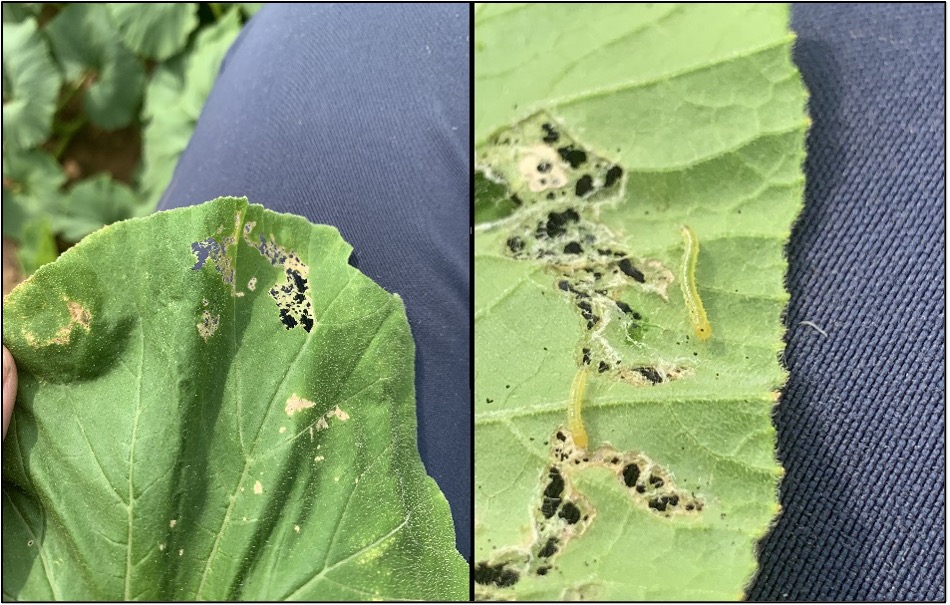
Picture 1 – Melonworm larvae on pumpkin leaves in Kibler, AR, 8/08/2023. Pictured left are signs of feeding on tops of leaves, and right the early-instar larvae feeding underneath. Picture by Ryan Keiffer
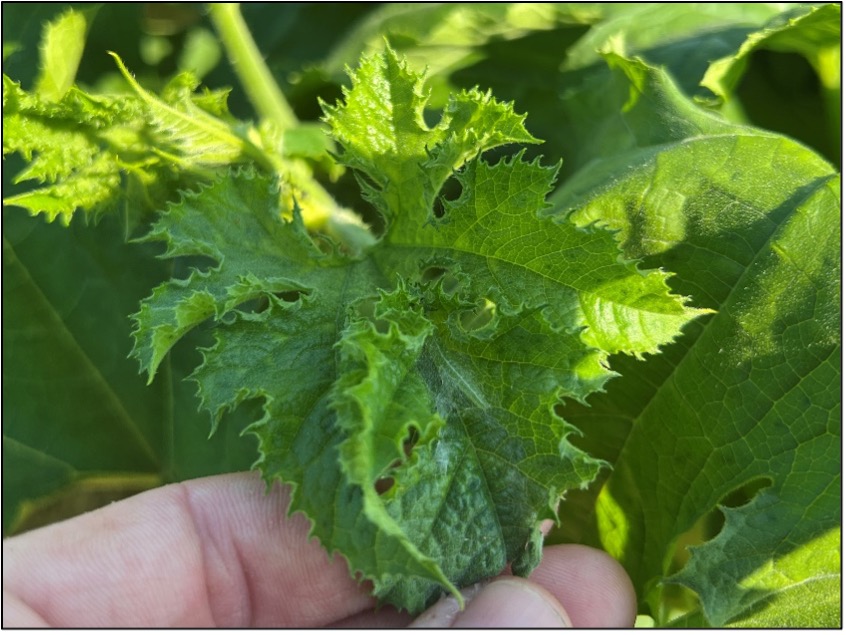
Picture 2 – Melonworm pictured on pumpkin in Hope, AR on 8/15/2024. Melonworm can often be observed first in new pumpkin growth as pictured above. Picture by Aaron Cato.
In the last five years we’ve been tracking the arrival of melonworm in the state in our trials near Ft. Smith, and more recently in SW and SE Arkansas. Below are our first observations from 2020-2024:
|
Year |
First Melonworm Observation |
State Impact |
|---|---|---|
|
2020 |
9/03 in NW AR |
Sporadic losses |
|
2021 |
9/7 in NW AR (Likely mid-Aug arrival) |
Widespread losses |
|
2022 |
9/19 in NW AR |
Sporadic Infestations |
|
2023 |
10/10 in NW AR, 8/30 in SW |
Few Issues (Some Damage in SW) |
|
2024 |
8/08 – in NW AR, 8/15 in SW |
– |
Based on observations from 2020-2024, melonworm arrival in NW Arkansas by early September signals a problematic year. In our recent bad years, 2020 and 2021, melonworm were easy to find in our trials in Kibler, AR (Near Ft. Smith) by early September. 2021 is a bit of an anomaly because we were less aware of the risk and habits of melonworm and weren’t looking for it prior to September. It’s likely that it was present in Arkansas in August, similar to how we are observing it this year. In the last three years we’ve scouted heavily throughout July and September after planting, which is likely why we found it so early in 2024. What we do know is that the intensity of infestations each year could be related to how early they show up in the state, which means that growers need to be scouting fields now. See below for more information about melonworm.
What is Melonworm?
Melonworm, Diaphania hyalinata, is a pest of pumpkins that feeds just under handles and etches the rind of pumpkins. There is a lot of confusion as to what pest species we are seeing in Arkansas pumpkins with names such as “rindworm” or “pickleworm” being used. Pickleworm is a different species, Diaphania nitidalis, and not one that we often see outside Southern Arkansas. Much of this confusion comes from the sporadic nature of this pest and how quickly damage can sneak up on growers.
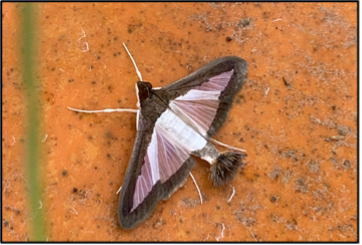
Picture 3 - Melonworm moth on a mature pumpkin. These moths are easily observed on fruit or leaves during daytime hours and are easily disturbed. Picture by Aaron Cato.
Melonworm Biology
Melonworm is a tropical moth species (Picture 3) which migrates to Arkansas from coastal regions in August-October, with arrival times varying from year-to-year. It’s possible that movement of melonworm to Arkansas is a function of tropical storm activity that tracks in our direction from areas of Texas, Louisiana, and Florida. Larvae generally take around 14 days to develop from egg to pupation, and the pupal stage lasts from 9-10 days, meaning a generation time is around 25-30 days. Larvae are green caterpillars with two longitudinal, white stripes down their back and 4 sets of prolegs (Picture 4 and 5). Larvae can quickly defoliate leaves of pumpkin plants when at high density and leave a “skeletonized” appearance with only the leaf veins remaining (Picture 6). You can often find larvae hiding under rolled, or turned pumpkin leaves, encased in webbing as seen in (Picture 6). Melonworm larvae can quickly begin to feed on the rind of pumpkin fruit and burrow under the stem/handle which can cause the stem to pull off when picked up (Picture 7). Feeding on the rind results in the fruit ultimately becoming unmarketable.
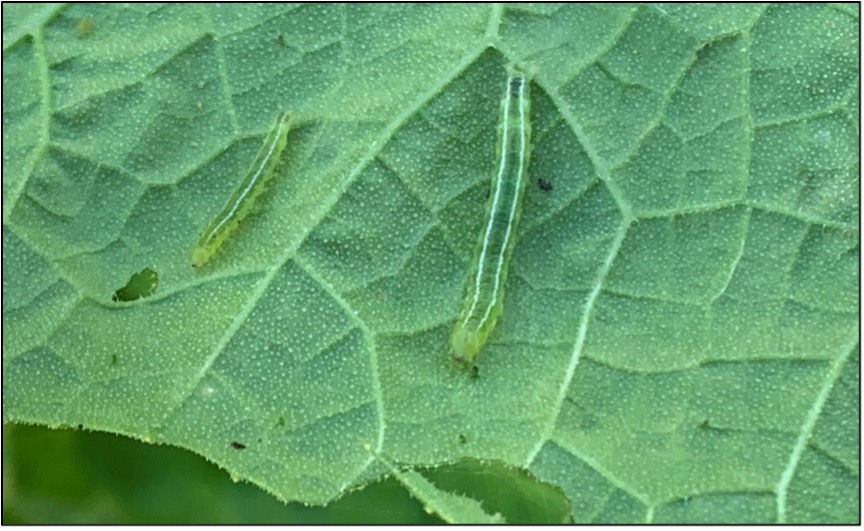
Picture 4 – Melonworm caterpillars present on the underside of a pumpkin leaf. These larvae can be identified by their green color and the two white stripes on their back. Picture by Aaron Cato.
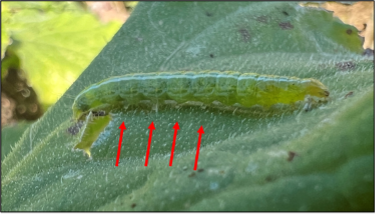
Picture 5 – Melonworm larvae pictured on a pumpkin leaf. Melonworm have 4 prolegs which will distinguish them from other caterpillars such as cabbage looper which are common on pumpkin. Picture by Aaron Cato.
Melonworms don’t overwinter in Arkansas, meaning their arrival each year depends on the climatic conditions throughout the Spring and Summer months. In 2021 moths showed up much earlier than previous years (Likely in August) and began multiplying rapidly before pumpkin harvest started. Significant damage was easy to see at many commercial pumpkin operations across the entire Midsouth and into the Midwest by late September. In 2022 a low density of melonworm was observed starting on September 19, and infestations were not widespread. In 2023 we observed melonworm movement across the state to be even slower, and we never found them in commercial fields. Although we observed melonworm larvae and significant fruit damage early in SW Arkansas, it took two full months for moths to make it to North Arkansas with very little weather movement helping them along. When and where melonworm arrives in the state is key when considering their generation time of around 25-30 days. If arrival in North Arkansas occurs in early august, you can expect 2 full generations to occur before fruit are most susceptible to damage during the October pumpkin patch harvest window.
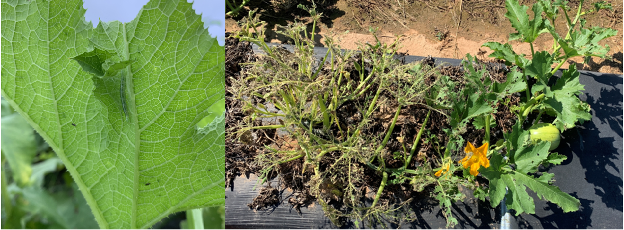
Picture 6 – Feeding damage caused by melonworm which is usually characterized by “skeletonized’ leaves that only have veins remaining in high density (pictured right) or by rolled leaves (pictured left). Pictures by Aaron Cato.
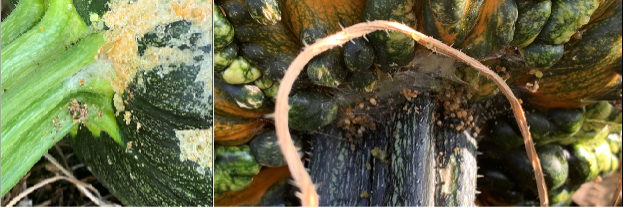
Picture 7 – Melonworm larvae feeding just under the handle/stems of pumpkins. Look for webbing or excrement, as shown in this picture, as an indication that larvae are feeding underneath. Pictures by Aaron Cato.
Melonworm Management
Melonworm can be a very serious pest of pumpkins and growers need to consider control every single year. In 2021 it was our key pest and proper scouting, along with well-timed insecticides, could have prevented most of the fruit injury that was incurred. Pumpkins should be scouted for melonworm larvae 1-2 times a week starting in late August. Focus early scouting efforts on the first signs of melonworm, which include feeding on leaves (Picture 1) and melonworm present in new growth (Picture 2). It’s also important to keep an eye out for moths (Picture 3) and rolled leaves (Picture 6). Fruit injury can occur very quickly after melonworm arrive, so fruit should be scouted for injury even when melonworm haven’t been observed yet (Picture 7). In 2022 we observed damaged fruit on the first day we found melonworm, likely because we were scouting once a week.
Melonworm seem to prefer jack-o-lantern pumpkin varieties more than others grown for the fall market, which indicates that we could integrate cultural control into our management programs. In 2023 we assessed eight varieties of pumpkins across 4 different species of Cucurbita, to assess whether there was a difference in attractiveness by species (Figures 1, 2, and 3). Preliminary data indicate that pumpkins derived from Cucurbita moschata, such as ‘Fairytale’ and ‘Buckskin’, exhibited less melonworm larvae than our typical jack-o-lantern pumpkins, which yielded less injured fruit. However, Cucurbita pepo is highly attractive to melonworm and includes all jack-o-lantern varieties. Currently our results don’t suggest that you can avoid insecticides in any variety, especially with only one year of data. We are replicating this trial currently in 2024 and hope that we can get more data at multiple sites with heavier infestations of melonworm.
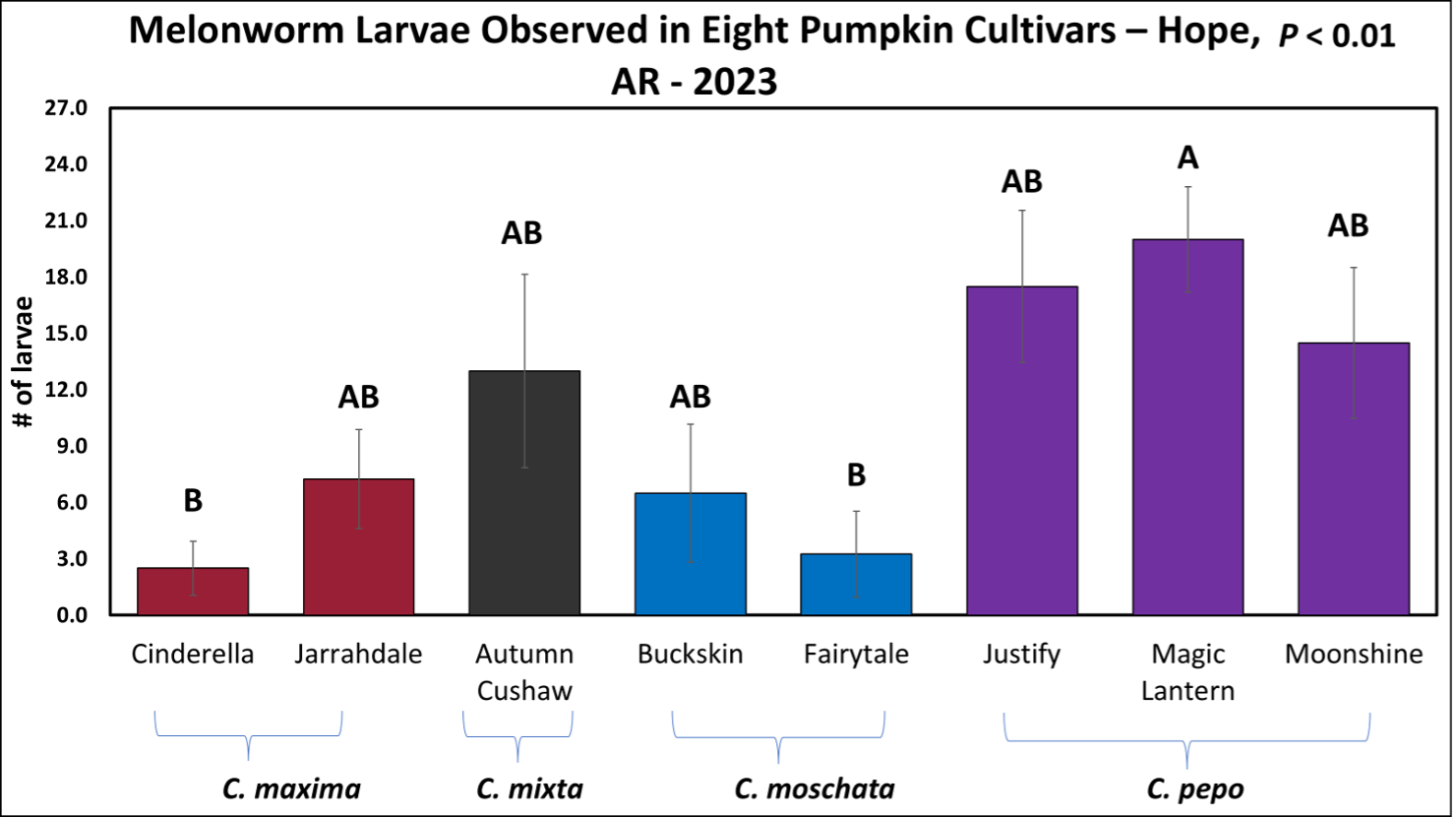
Figure 1 – Number of melonworm larvae observed on eight varieties of pumpkins across four different species of Cucurbita in Hope, AR in 2023. ‘Cinderella’ and ‘Fairytale’ exhibited significantly fewer melonworm than ‘Magic lantern’. In general, varieties in Cucurbita pepo exhibited more melonworm larvae than any specialty pumpkin variety.
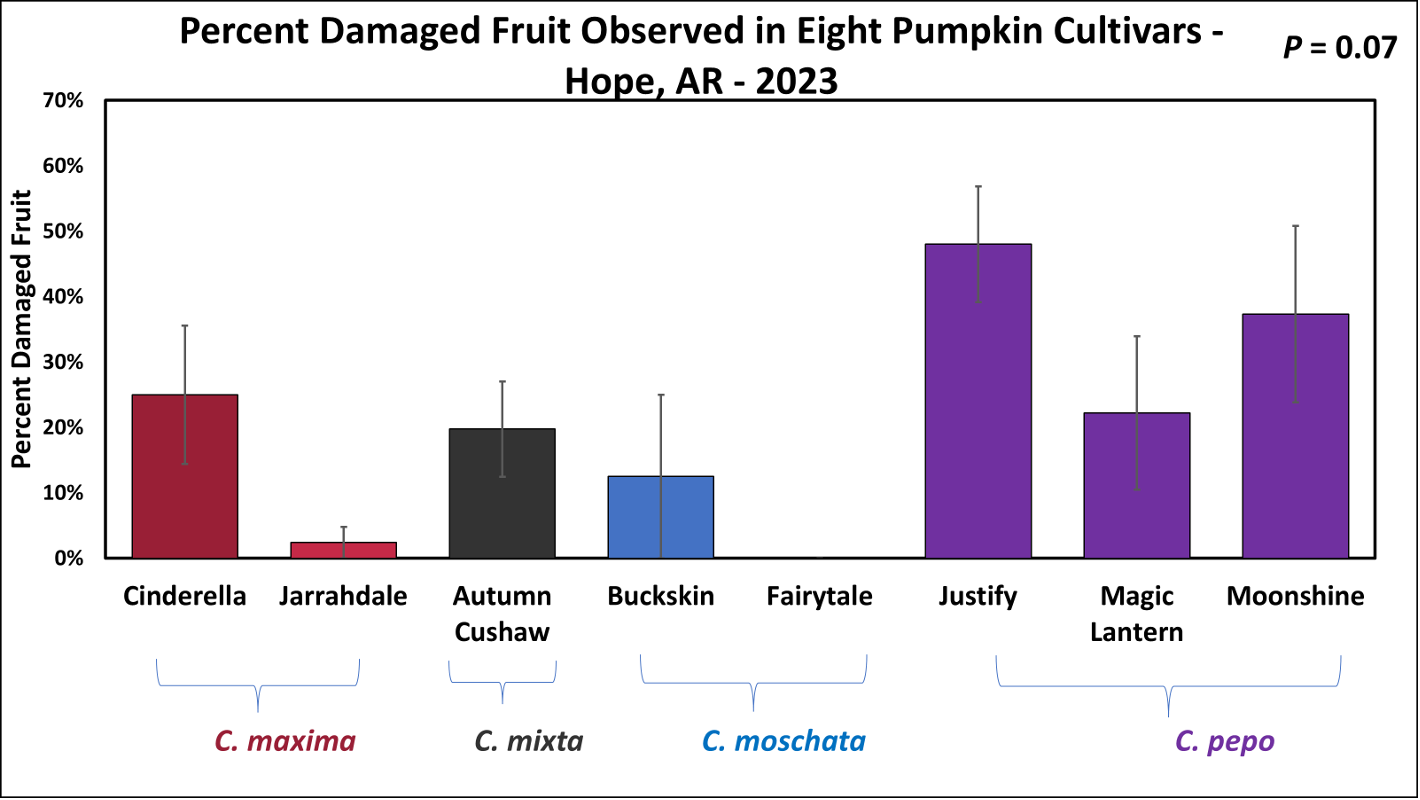
Figure 2 - Number of melonworm damaged fruit observed on eight varieties of pumpkins across four different species of Cucurbita in Hope, AR in 2023. No significant difference was observed when comparing fruit damage, but varieties in Cucurbita pepo exhibited more damage than any specialty pumpkin variety. No injury was observed in ‘Fairytale’ and less than 5% was observed in ‘Jarrahdale’.
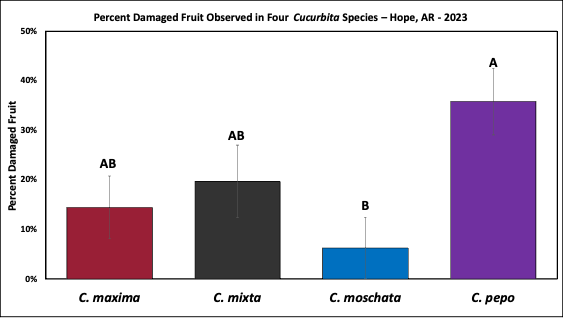
Figure 3 - Number of melonworm damaged fruit observed on four different species of Cucurbita in Hope, AR in 2023. Cucurbita moschata exhibited significantly fewer damaged pumpkins compared to Cucurbita pepo, which was more impacted than any other species at over 30% damaged fruit across 3 varieties.
We recommend applying an insecticide as soon as melonworm larvae or moths are observed in a pumpkin planting. Many effective products for melonworm are available but effective residual control for each product will lead to more favorable results. Caterpillar specific products containing chlorantraniliprole (IRAC 28 – Besiege, Coragen or Shenzi), cyantraniliprole (IRAC 28 - Exirel), or cyclaniliprole (IRAC 28 - Harvanta) will offer the longest residuals and should provide at least 21 days of residual control. Other caterpillar specific products such as spinetoram (IRAC 5 - Radiant) and methoxyfenozide (IRAC 18 - Intrepid), and also broad-spectrum insecticides such as pyrethroids (IRAC 3A - bifenthrin, lambda cyhalothrin, etc.) will provide 5-7 days of control and may offer less efficacy (Figure 2). These insecticides should be reapplied in 7 days if moths or larvae are still being observed.
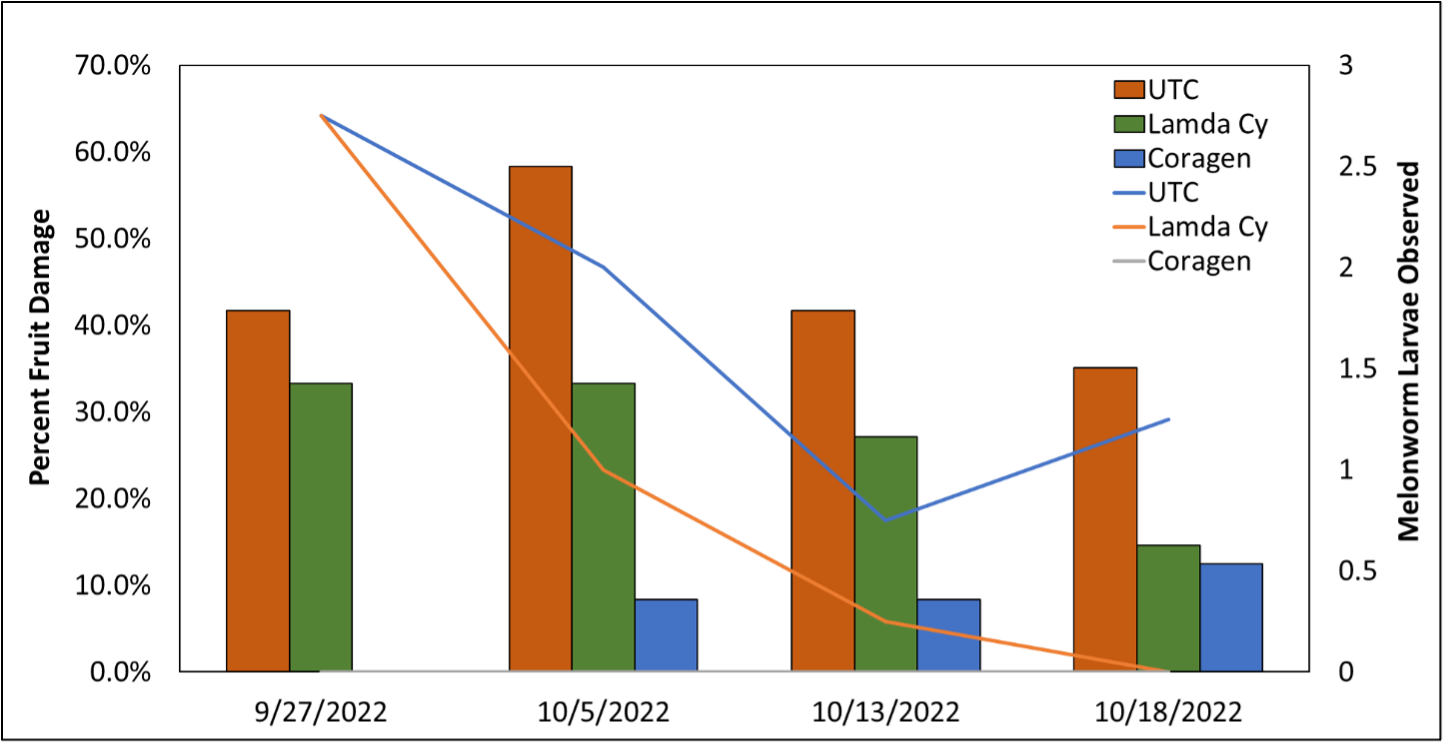
Figure 4 – Melonworm efficacy trial from 2022 in Alma, AR on pumpkins. An application of Lambda cyhalothrin (IRAC 3A – pyrethroid) or Coragen (IRAC 28 – diamide) was made on 9/19 when melonworm moths and larvae were first observed and were compared to an untreated control (UTC). The left y-axis corresponds to the bars and indicates the percent fruit damage that was observed, while the right y-axis corresponds to the lines and indicates the number of melonworm larvae observed in plots with 3 plants.
So What Should You Do About Melonworm?
Our observations over the last 5 years indicate that this pest may be serious every year, and we aren’t good enough to predict the severity yet prior to Mid-Late September. Scout pumpkins twice a week and be ready to put out sprays for melonworm ASAP. Keep an eye on our Facebook page and IPM Webpage where we will let you know when we first find melonworm in the state and give updates on severity at multiple locations. We recommended you have a diamide insecticide (Besiege, Coragen, or Shenzi) on hand and apply as soon as you find any melonworm in your pumpkins. Some people are applying when melonworm is found close by, which may not be a bad idea with how quickly it can get to fruit. I would recommend Coragen over Besiege because the lambda-cyhalothrin in the besiege will flare aphids, but consider the price and what you can actually find easily. If you spray September 1st, be ready to reapply September 22nd if you continue to find any melonworm at all. If you are applying other effective chemistries for things like squash bug or cucumber beetle, consider that they are giving you 5 or so days of control. However, as you can see in our data from 2022 (Figure 4), we found melonworm on 9/19, sprayed a pyrethroid that day, and still incurred 30% fruit damage while our diamide insecticide plot was clean the next week. This is likely because coragen gets into leaves and more effectively controls the holed up melonworm which will eventually move down to fruit, maybe after pyrethroid residual effectiveness is gone.
As always give me a call if you have any questions at all.
Aaron Cato
479-249-7352